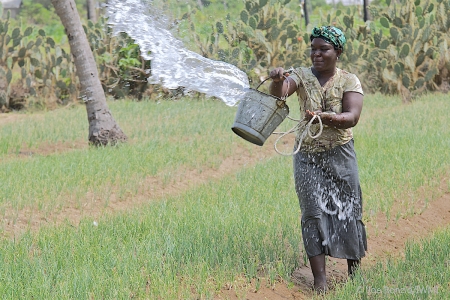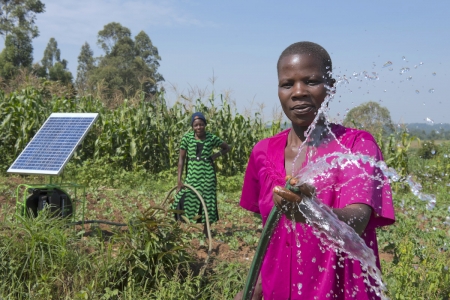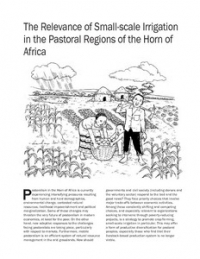Bio-fertilizers including rhizobium inoculants are intended to improve soil fertility either through biological nitrogen fixation or increased nutrient availability and uptake by crops. However, various soil properties affect the performance of most bio-fertilizers. Hence, site effects of crop responses to biofertilizers (spatial variability) are expected. Therefore, it is intended to assess soil factors limiting crop responses to inoculants. For instance, previous results (2012-2014) showed low legume responses to rhizobium inoculants when available phosphorus is too low, nitrogen levels all very low or high, soil pH is very acidic, etc. However, the effect of soil texture and organic matter content in various agro-ecologies are not well understood. Similarly, the threshold values to determine when interventions are necessary are not well-established. Landscapes and niches within agro-ecologies as well as cropping systems are considered to capture the spatial variability in crop responses in relation to soil fertility, and size and function of native strains. The investigation therefore intends to determine the most limiting factors related to soil governing crop responses to inoculation as well as setting threshold values to which changes to responses are found. In addition to rhizobium inoculants, other inoculants such as mycorrhizae are investigated for their ability to improve crop nutrient availability, agronomic efficiency, and use efficiency, as well as the tolerance to abiotic stress such as drought. Interactions between rhizobium, mycorrhizal inoculants or trichoderma have not significantly been evaluated in various agro-ecological zones of sub-Saharan Africa (SSA). The projects will also focus on: developing variety x inoculant x nutrient management recommendations for the target legumes and legume production areas based on yield gap analysis, develop recommendations for rehabilitation of non-responsive soils for legume production, and unravel GL x GR x E x M interactions for legume production towards the development of best-fit recommendations. Bio-fertilizers are considered cost effective. Improving their use-efficiency will allow resource disadvantaged smallholder farmers access to affordable technologies intended to improve crop yields, soil health and sustainable land use and agricultural intensification. The resulting improvement of crop yields is expected to contribute to improved income and better investment in sustainable use of agricultural lands by the smallholder farmers. The projects involve 11 countries of which Democratic Republic of Congo, Ethiopia, Ghana, Kenya, Malawi, Mozambique, Nigeria, Rwanda, Tanzania, Uganda and Zimbabwe. The research involves collaboration with the national agricultural research systems and agricultural universities to develop their capacity. Partnership with the private sector is highly being developed and promoted to improve the availability of profitable bio-fertilizers and other agricultural technologies of interest. The assessment of the various technologies to improve crop productivity and soil health is done in participatory manner by actively involving the direct beneficiaries (i.e. smallholder farmers) in experimenting the agro-inputs of interest. The COMPRO-II project will also advocate for adequate policies and regulatory frameworks (in collaboration with policy makers) to ensure that only high quality technologies are exposed to smallholder farmers. The methodology to increase soil fertility is as follows: first of all, demonstration trials of bio-fertilizer technologies are implemented on farm in various agro-ecologies. Based on crop responses, we evaluate soil factors responsible for the spatial variability of the responses. Once those limiting factors are identified, appropriate interventions/treatments are applied to improve the crops responses. The improved interventions are again tested on farms. Hence, it is an iterative process. The purpose is to develop specific recommendations for each agro-ecological zones or regions to improve soil productivity. The best bet combinations will be scaled up by the development partners involved in the project in the various countries. The scaling up approaches include field days, leaflets, posters in the project regions, flyers, video messages, flipcharts on the application of the technologies, as well as phone and radios messages among others to increase the awareness of various stakeholders including farmer organizations, agricultural extension agents, and policy makers. Over sixty development partners (mainly NGOs) with significant experience in scaling up agricultural technologies are involved in the implementation of the activity in the 11 countries. Some of the development partners will get budget from the projects, while others are just users of the projects know-how, and technologies to implement their own initiatives using their own budget. Also, those development partners are being or will be trained to improve their understanding of the agricultural practices being scaled up. This work plan lists the key ones; however, a comprehensive list of those partners has been submitted to WLE management for records. For instance, the experience of CAB International, Farm Radio International, Farm Inputs Promotion Africa, Africa Agricultural Technology Foundation, Alliance for a Green Revolution in Africa, Catholic Relief Services, Clinton Hunter Foundation etc is well-established. It is also worth mentioning that the national extension services and learning institutions in the various countries are involved. The initial title recommended for 2015, 'Participatory approach to identify soil factors limiting crop productivity and soil health and address them through disseminate profitable agricultural technologies including bio-fertilizers to increase nutrient agronomic efficiency in various cropping systems for sustainable land use' was recommended based on recent re-mapping of COMPRO-II and N2Africa under various CRPs. However, following the recommendation of the reviewers the title of 2014 is now used, but the sub-activities remain particularly the same. It is important to note that COMPRO-II and N2Africa activities specific to grain legumes are reported under CRP 3.5 (mainly legume productivity), whereas project activities related to ecosystem services resilience are mapped under CRP5 (WLE) (mainly sustainable land use for sustained soil productivity). To facilitate the comparability of the results across countries similar protocols for products testing (experimental design and treatment structures) and scaling up of the technologies have been developed. However, the protocols still have to be tailored to the local conditions. This will facilitate the application of meta-analysis to determine whether some of the findings could be generalized. The spatial variability will be documented to inform policy and industry decisions in terms of tailoring the various technologies or agricultural inputs' formulation to the local conditions. In the particular case of mycorrhizae products and phosphorus solubilizing bacteria the P fertilizer equivalent will be assessed. With respect to gender, not only that women farmers will be involved in the assessment of the technologies (participatory approach), they will be involved in the training of other farmers and empowered with adequate training (training of trainers). Development partners will collect feedback from women participants for better understanding of the need to adopt the technologies being scaled up and determine the appropriate solutions. Solutions at the reach of the project will be implemented, while recommendations including policy needs will be formulated for consideration by the relevant stakeholders including policy makers and donor organizations among others. The projects are mainly funded by the Bill and Melinda Gates Foundation.
menu











